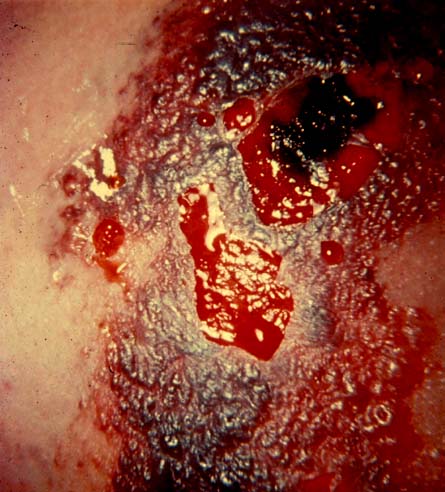What is Anthrax

Anthrax (disease) - an illness resulting from INFECTION with the bacterium Bacillus anthracis. Anthrax is a naturally occurring infection among wild and domestic livestock (such as cows, sheep, goats, and antelope). Anthrax is rare in people in the United States, though more common in people who live, work, or travel to countries where anthrax is more common in livestock. The BACTERIA can cause infection in people who are exposed to sick animals, such as workers on farms and in slaughterhouses. Ranchers and farmers in the United States vaccinate their livestock against anthrax. An anthrax VACCINE is also available for people.
Symptoms of Anthrax and Diagnostic Path
Symptoms of anthrax depend on the form of illness. Anthrax in people can take three forms:
- Cutaneous anthrax, which accounts for 95 percent of human anthrax infections, results when B. anthracis enters an opening in the SKIN, such as a small scratch, and causes ulcerated sores on the skin. It is highly treatable with ANTIBIOTIC MEDICATIONS and nearly everyone who receives antibiotic therapy recovers without complications.
- Inhalation anthrax results when a person breathes B. anthracis into the LUNGS, where the infection causes life-threatening PNEUMONIA. Inhalation anthrax requires urgent intravenous antibiotic therapy and intensive medical care. It is difficult to avoid respiratory collapse and cardiovascular shock, which are often fatal.
- Gastrointestinal anthrax results from eating meat contaminated with B. anthracis. It causes NAUSEA, VOMITING (often bloody), FEVER, ABDOMINAL PAIN, and profuse DIARRHEA. Many people recover, but the illness can be life threatening.
The diagnostic path includes a comprehensive history of potential exposure to livestock or livestock products and BLOOD tests to identify the presence of characteristic antibodies. The doctor may also culture body fluids to look for B. anthracis.
Anthrax Treatment Options and Outlook
Antibiotic therapy is the mainstay of treatment for all forms of anthrax. The earlier treatment begins, the more effective it is. Untreated anthrax in any form can be serious or fatal. A person who has anthrax cannot spread the infection to others, though health-care providers follow diligent infection control protocols when treating people who have anthrax.
| ANTIBIOTIC MEDICATIONS TO TREAT ANTHRAX | |
|---|---|
| ciprofloxacin | doxycycline |
| levofloxacin | penicillin |
Risk Factors and Preventive Measures
Exposure to potentially contaminated livestock or livestock products (meat, hides, fur) is the primary risk for naturally acquired anthrax. A vaccine to prevent anthrax is available; however, current guidelines recommend its administration only to people at high risk for exposure to B. anthracis or after suspected exposure to B. anthracis. Multiple doses over 18 months, with annual boosters, are required to establish and maintain IMMUNITY.
In the late 1990s anthrax emerged as a worldwide bioterrorism threat, with concern for the possibility of widespread infection after intentional contamination of the US mail with B. anthracis caused two dozen Americans to become ill with anthrax, five of whom died from the inhalation form. At present public health experts recommend the vaccine in combination with antibiotic therapy to prevent illness in people exposed to B. anthracis.
See also ANTIBODY; FOODBORNE ILLNESSES; SMALLPOX.
Open discussion on the topic Anthrax (disease) - What is, treatment and symptoms
Similar interests
- Casino Non Aams
- Nuovi Casino
- Casinos Not On Gamstop
- UK Casinos Not On Gamstop
- Casinos Not On Gamstop
- UK Casinos Not On Gamstop
- Casino Non Aams Italia
- Slot Sites Not On Gamstop
- Meilleur Casino En Ligne
- Non Gamstop Casino Sites UK
- Meilleur Casino En Ligne
- Casino En Ligne France
- Best Non Gamstop Casinos
- Casinos Not On Gamstop
- UK Casino Not On Gamstop
- Casinos Not Signed Up To Gamstop
- Best Slot Sites UK
- Non Gamstop Casino Sites UK
- Online Casinos Nederland
- Online Casinos Nederland
- Casinos Not On Gamstop
- Best New Uk Casinos Not On Gamstop
- Casino Non Aams
- Non Gamstop Casinos UK
- Migliori Siti Casino Non Aams
- Bitcoin Casinos
- Sites De Paris Sportifs Belgique
- Bookmaker Non Aams
- Casino En Ligne
- Casino Nouveau En Ligne